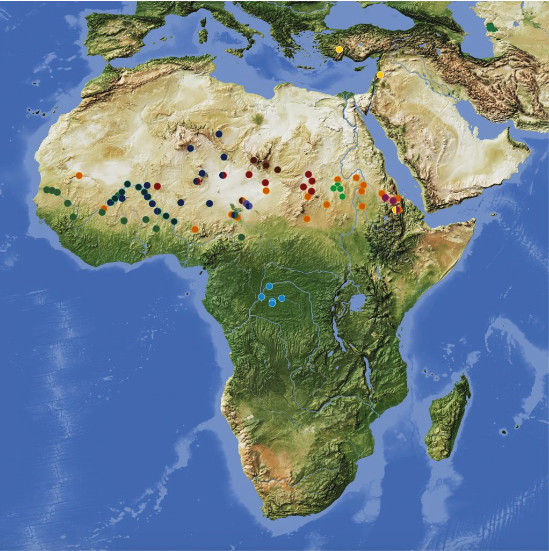The ARIADNE RI is delighted to welcome the Data Centre for the Humanities of the University of Cologne (DCH der Universität zu Köln) as a new member. The DCH will be contributing the data created by projects from the priority-programme 2143 “Entangled Africa”, funded by the German Research Foundation (DFG), to the Portal. DCH runs the FAIR.rdm project (to provide conceptual and technical support for research data management) and there is also a separate co-ordination project making 13 in all.

Map showing Entangled Africa research project areas of interest. Attribution: Michael Schmeling, licensed under CC BY 4.0 international, waterbodies © OpenStreetMap contributors, modification by Johanna Sigl
The combined data collections vary widely in scope, from studies of artefacts to soil samples, chemical analyses, linguistics and dendrochronology. It is anticipated that there will be over 1,000 records to upload into ARIADNE. A brief description of the projects is as follows, a full description of each one can be accessed on the Entangled Africa website via the title links:
- Necked axes from the Sahara, north Africa – a typology g. form, size, raw material, traces of production and use, of a specific type, the Darfur axe, will be developed with the results available in the African Archaeology Archive Cologne (AAArC).
- The Connecting Foodways project focuses on the study of food preparation areas or ‘kitchens’, and humble, handmade cooking pots, and the cultural life of the people who used them during the early Iron Age (c. 1000 BC – AD 1000) from the Middle Nile Valley and central and eastern Africa.
- Interregional Linkage Investigations in Northern Kordofan is looking at the cultural connections between the Jebel al-Ain region, and the Nubian Nile valley following several archaeological discoveries there.
- The Lake Chad Region as a Crossroads project will generate objective information on Kanem-Borno’s early historical connections, thus contributing to a broader understanding of Africa’s entangled past in Medieval times.
- Cultivated Landscapes aims to develop a model which relates formation, propagation, and development of cultural landscapes to land-use practices and their connected social processes, such as the adoption of certain livelihoods and innovations, as well as to the environmental settings of the north-hemispheric African savannahs.
- ‘De-Greening‘ of the central Sahara is investigating palaeoecological shifts using sedimentary archives from (1) The groundwater oases of Ounianga within the central Sahara (19°N) and (2) the Kanem Region east of present Lake Chad in the Sahel.
- Routes of Interaction: Interregional Contacts between the Northern Horn of Africa and the Nile Region investigates the various forms of mobility and routes of interaction between the highland cultures of the northern Horn of Africa and the cultures of the middle Nile River, the north-eastern Sudanese Gash Delta, as well as parts of Egypt.
- ClimCellMed stands for “Climate dynamics during the late Holocene derived from cell structure measurements of juniper trees in the eastern Mediterranean”, this project is utilising a recently developed method applying confocal laser scanning microscopy for measuring cell structures of tree rings going as far back as 3,000 BC.
- Connecting the lower middle Niger through borrowed words and shared objects: Archaeo-linguistic network analysis and modelling of cultural entanglements between the Malian Sahara and the Nigerian forests (AD 700–1500).
- Archaeology and Palaeoecology of the Inner Congo Basin will look at immigration from the early Iron Age and will create a Holocene-Late Pleistocene palaeoecological baseline sequence for the area, allowing certain hypotheses to be tested.
- Tracing Connections is using chemical analysis of archaeological pottery as indicator of interregional contacts in Western and Saharan Africa before AD 1300.
The teams involved in these projects come from various institutes based at the Universities of Cologne, Münster, Frankfurt, Berlin and Potsdam, the German Archaeological Institute (DAI) and Université de N’Djamena in Chad. Their data will (spatially) complement the resources from ROCEEH which are mainly located in east and the southern African countries.

